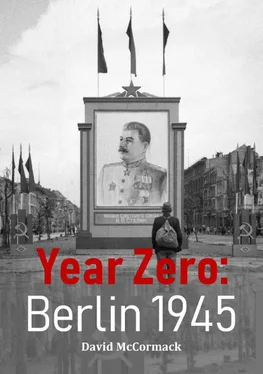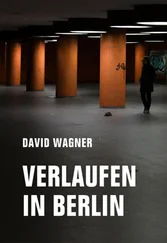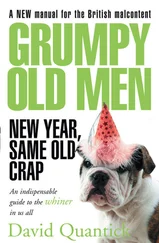Fritzsche: I wrote a letter to you, being the last responsible representative of the government. I wrote it in order to avoid bloodshed.
Sokolovskii: We understand your enforced gesture.
Fritzsche: I would like to expand this document, for which purpose I need to establish contact with Doenitz.
Chuikov (to Fritzsche): At nine o’clock this morning, Doenitz addressed himself to the army and the people with a declaration that he had taken the leadership upon himself and that he would continue the struggle against Bolshevism to the end, and likewise against the Americans and the British if they hindered him. But we are not afraid of him; he has bitten off more than he can chew.
Fritzsche: I did not know that. Where am I to remain?
Sokolovskii: Here. Await our further instructions.
Fritzsche was then led away, his part in the drama effectively over. Later he would be transferred to the notorious Lubyanka Prison in Moscow where he underwent torture. Later, he was tried as a major war criminal at Nuremberg, subsequently being acquitted along with fellow defendants Franz von Papen and Hjalmar Schacht.
Following Fritzsche’s departure, Chuikov and Sokolovskii visibly relaxed, chatting informally as the tension created by the protracted surrender negotiations evaporated. Meanwhile, news came in confirming that the fighting for the Reichstag had finally come to an end with the surrender of the last remaining German defenders. With the end of a long and cruel war now clearly in sight, Sokolovskii remarked, ‘The end of the war is approaching’. Chuikov quipped, ‘Yes, let’s smoke a pipe of peace!’. The end was indeed approaching, as in the shattered streets of Berlin, Soviet vehicles equipped with amplifiers played recordings of Weidling’s surrender order.
At 15.00hrs, the Soviet guns fell silent. The time for reflection would come later. For the victors, it was a time of celebration as they broke out the food and drink. Along the East-West Axis, the crews of T-34 and IS-II tanks embraced, thankful that they had somehow survived. In his memoirs, Chuikov wrote about the end of hostilities. His words contain an inevitable note of nationalistic pride, but also a sense of relief that the long struggle was over:
We went into the streets outside. All around was quiet – an unaccustomed quiet that rang in our ears. Somewhere not far off, ranks of soldiers were marching smartly, in perfect time. It was hard to believe that our Guardsmen had already found time to acquire such harmony and precision with drill movements. Yet how else could it be at such a time! Weariness had given way to pride and joy. The marching men came nearer. It was a company from the 79 thGuards Division… The company was led by Captain N.I. Kruchinin; he had just completed the clearing of the east bunker of some Nazis who had tried to continue resistance. The last shot in the Berlin fighting had just been fired there. The last shot!.. Step for step, foot to foot, shoulder to shoulder. The heroes of the land of Russia came through the streets of conquered Nazism’s capital. And a ringing song came through the clear air of the city where the leaders of the Third Reich had matured their plans for world domination. The war was over. A long and hard road had been travelled.
As Soviet troops celebrated and congratulated each other on their own survival, the last survivors of the break-out groups which had set off from the Chancellery the night before were being rounded up. There were numerous other break-out attempts, most of which ended in complete failure. Only a few determined individuals made it through the Soviet lines to reach safety west of the Elbe.
In the gloomy depths of the bunker, the atmosphere following Hitler’s suicide was a mixture of high tension and Wagnerian melodrama. Those who planned to break-out anticipated the moment of their release, whilst the few who had opted for suicide made speeches about loyalty and honour. After the suicide of Goebbels, all remaining obstacles to the proposed break-out were removed. The first group to leave was led out by Mohnke at 23.00hrs on 1 May. He had formed ten groups of between twenty and thirty people, each of which would set off at ten minute intervals. The basic plan was for all groups to make their way as far as the Stettiner Railway station by using U-Bahn and S-Bahn tunnels as much as possible. In theory, this would bring the groups out behind the Soviet lines. From here, they would head towards the Gesundbrunnen Railway Station. Then each group would attempt to make its own way to Neuruppin, where they would find safety with the main German forces. Such was the plan. In reality, it had little chance of success as Mohnke was unaware of the collapse of German units fighting to the north of Berlin around Oranienburg.
Mohnke’s group, containing among their number Gunsche (Hitler’s Adjutant), Walther Hewel (Diplomat), Hans-Erich Voss (Vice-Admiral) and the female secretaries, crawled out through a cellar window in the Chancellery which led on to the devastated Wilhelmplatz. From here, the group descended into the depths of the Kaiserhof U-Bahn Station. Using their torches to penetrate the enveloping darkness, the group made their way along the tracks to the Stadtmitte Station. From here, they continued their trek to Friedrichstrasse Station. Strangely, the group’s progress was halted at the entrance of a nearby tunnel running under the Spree by two watchmen. Having received no new orders in over a week, the watchmen refused to open the water-tight bulkhead. Accepting the situation without demur, Mohnke led the group back to Friedrichstrasse Station, from where they were forced to continue their attempted break-out above ground. The Weidendammer Bridge was blocked by a German anti-tank barrier. However, the group were able to make their way across the Spree via a nearby metal footbridge. From the ruins of the Natural History Museum, they witnessed Friedrichstrasse and the Weidendammer Bridge coming under heavy Soviet fire.
The other groups had set off as planned. Bormann was a member of the third group which was led by Werner Naumann (Promoted to Minister of Propaganda in Hitler’s political testament). However, the original plan unravelled quickly as the groups lost touch with each other in the underground gloom. Naumann’s group had become disorientated in the murky underground tunnels and so decided to continue their break-out above ground. Meanwhile, Soviet troops had become aware that an attempt to break through their lines was occurring. The mounting confusion was added to by an ad hoc break-out attempt by some of SS Major-General Krukenberg’s foreign volunteers from the Nordland Division who employed five Tiger tanks to blast their way through the anti-tank defences north of the Weidendammer Bridge. Fierce battle ensued in which all five tanks were destroyed and the Nordland volunteers suffered heavy casualties. Bormann and Hans Baur (Hitler’s personal pilot) were caught up in the battle. In the chaos they temporarily lost sight of each other. After approximately twenty minutes had passed, Baur noticed Bormann sitting alone at the entrance of a burnt out building on the corner of Friedrichstrasse and Schifffbauerdamm.
Meanwhile, Mohnke had taken advantage of the confused and chaotic situation to take his group up Chausseestrasse. From here, they made their way to the goods yard near the Stettiner Railway Station, where they were later joined by the survivors of the Nordland troop’s break-out attempt. Mohnke’s group had now swelled to some 150-200 people as they had been joined by more German troops along the way. Stopping briefly at the Humboldthain Flak Tower which was still strongly defended, the group then pressed on to the Schultheiss Brewery on Prinzenallee. Here, the group took shelter with several hundred other troops (including naval personnel flown in by Doenitz). Their predicament was made more comfortable by the large stocks of beer still stored on the premises. By early evening it was clear that there was no way out and that surrender was their only option.
Читать дальше












